In one of the most drastic meta shifts in the history of Hearthstone, Druid is now the most popular class in the game after it was the least popular class in the game immediately after Descent of Dragons launched. Most of this change can be attributed to a single deck, Embiggen Druid, that took the meta by storm after the first week of Galakrond’s Awakening became available. Everyone has had to adjust to this new threat, and it does look like Druid is now past its peak against new competition, even though it still remains a powerful force.
But where did this deck come from all of a sudden? What are the origins of Hearthstone’s success stories? In this article, I take a look at how Embiggen Druid came to life and what finally pushed it through to mainstream success.
If you’re looking to play Embiggen Druid yourself, take a look at our Embiggen Druid Deck List Guide. If you’re more interested in what has made it good and why it is good now, keep reading this one.
Early Embiggen Druid (Early December 2019)
Embiggen Druid’s definitive pieces: Embiggen, Breath of Dreams, and Strength in Numbers were put in the same deck already in the first days of Descent of Dragons:
This early version failed to gain traction. Before the first nerf patch, Shaman was so utterly dominant against Druid that the entire class felt useless: 8/8 Rush minions coming at you, again and again, is something Druid simply cannot handle, because the class lacks hard removal. The deck saw a little more play after the first nerf patch that weakened Galakrond Shaman, but it was still not strong enough and its numbers dropped rapidly.
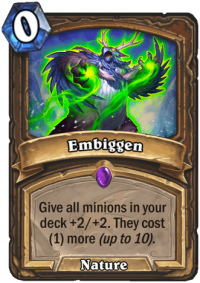
Compared to where we are now, this early innovation lacks optimization in several ways: Acornbearer and Firetree Witchdoctor contribute but little to the deck’s gameplan, because of their poor synergy with Strength in Numbers, and while the need for Rush minions to control the board was recognized already back then, the deck includes weak card choices by today’s standards, such as Scaleworm.
All of that is just a matter of sweat and work, though – all the core ideas of the current Embiggen Druid are present already in this deck. Interestingly enough, this deck was unfavored against Rogue, whereas the current Embiggen Druid’s main ticket to fame has been its strong Rogue matchup.
Embiggen Druid After the Shaman Nerf (Late December 2019)
Embiggen Druid gained a bit of traction after the Shaman nerf in December. Druid no longer faced an impossible challenge from multiple big minions early in the game, so the Embiggen concept was revisited with new approaches:
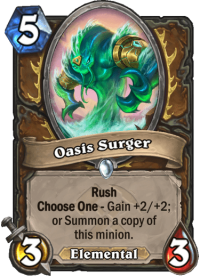
Curiously enough, this most popular approach to the archetype after the Shaman nerf went on to cut Strength in Numbers instead of the low-cost minions that synergize poorly with the Quest. Instead, the deck adds Savage Roar as a win condition, supported by SN1P-SN4P, Oasis Surger, and Leeroy Jenkins, three cards that would later on become core cards for the archetype.
The Rogue matchup has improved to an almost even one at this stage, because getting multiple minions on the board and then bursting the Rogue down is a viable strategy. The deck still does not excel at summoning a wide board though, so Savage Roar ends up being a dead card much of the time, even though it is game-winning when it works.
The small minion approach wins games here and there and is somewhat viable, but it remains an off-meta deck that cannot attract a mainstream following. It is simply not strong enough to carry people to Legend.
The Mainstream Embiggen Druid (January 2020)
The floodgates broke with the release of Galakrond’s Awakening, and Winged Guardian‘s arrival on its first week. Rapidly, this deck became the most popular deck in the entire game:
There have been various adjustments since, of course, and people are still tweaking the deck, but this version has proven itself to be solid and remains extremely popular.
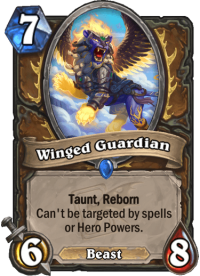
Why? What caused this deck to suddenly succeed? Sure, Winged Guardian was added to the game, but it is not even the best-performing card in the list. Rather, Winged Guardian is one of many high-performing minions in the deck, but Oasis Surger, Zilliax, SN1P-SN4P, and even Faerie Dragon all boast performance statistics comparable, or even superior, to the new addition.
The real stars of the deck are Embiggen, Breath of Dreams, and Strength in Numbers, but all of those were in the same deck together already in the very first days of Descent of Dragons.
Of course, the deck is now optimized further than that early deck. The weak early-game minions have been removed and replaced by stronger minions that synergize better with Strength in Numbers. Everything is more straightforward and the parts work better together.
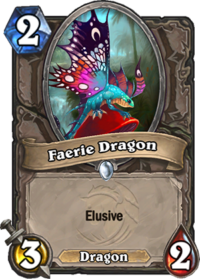
The meta is also very different after multiple balance patches. In particular, Rogue had become the deck to beat before the rise of Embiggen Druid, and many of the card choices in the deck are specifically good against Rogue. Rogues like to use spells on the opponent’s minions, and by using multiple minions that cannot be targeted by Rogues’ favorite spells, especially Backstab and Seal Fate, and to a lesser extent Sap, Embiggen Druid denies tempo and combo opportunities from Rogue: Faerie Dragon is one of the most annoying early-game minions for Rogue to deal with, and Injured Tol'vir dodges Rogue’s main early-game spells that require an undamaged target.
The deck is also relatively inexpensive, especially compared to all the Highlander decks that are available with the large card pool of a late Standard format. At 6820 dust (and the first wing of the Galakrond’s Awakening adventure), lots of people can afford to play the deck. It only uses three Legendary minions, and all of them are long-time staples: SN1P-SN4P, Zilliax, and Leeroy Jenkins. If you have been playing Hearthstone over the past year, those are among the most likely Legendary cards you can have in your collection.
How Essential Is Winged Guardian?
If Winged Guardian‘s performance is not far above other minions in the deck, how essential is it? Could Embiggen Druid have been discovered to challenge the Rogue meta even without Galakrond’s Awakening? As a matter of fact, after the early success of the deck, lots of players without the adventure attempted exactly that, and we have some fairly decent statistics on the performance of this list:
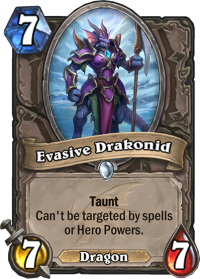
It is not a bad deck, really. Its biggest problem is that it is completely outclassed by Embiggen Druid with Winged Guardian, coming in at just over 40% win rate in the matchup. It is able to succeed against Rogue, something that was a highly desirable trait in a deck until Embiggen Druid took over the meta, and it is relatively solid overall. If this list had been discovered before Galakrond’s Awakening, it could have been a meta deck. Now, in a world where Embiggen Druid with Winged Guardian exists and where other decks are increasingly targeting it, a weaker version just will not do.
The deck uses Evasive Drakonid instead of Winged Guardian, but whereas Winged Guardian is one of the top cards in its deck, Evasive Drakonid is the worst-performing card in this list. A single card can make a difference.
The Next Meta Deck Could Still Be Waiting to Be Discovered
Whereas it might look like Embiggen Druid became a success overnight, that is hardly the case.
The three key cards of the deck – Embiggen, Breath of Dreams, and Strength in Numbers – were put together in a deck as early as the very first days of Descent of Dragons. However, Galakrond Shaman easily crushed them at that time, and the development of the deck first progressed to a different direction, away from Strength in Numbers and towards wider boards with Acornbearer and spell discovery with Firetree Witchdoctor.
These steps proved insufficient, but the move back to Strength in Numbers only came with the introduction of Winged Guardian to the game, as that was such a huge incentive to summon minions directly from the deck. However, looking at the performance of Embiggen Druid without Winged Guardian, the deck could have been found earlier, and it would have had a good chance in the Rogue meta, even though the Winged Guardian version is superior.
This progress clearly shows how the meta decks we have today are not necessarily the best decks. Druid was the least popular class quite deservedly in the early days of Descent of Dragons, as there was no way for it to compete with Shaman. However, once the Rogue meta began to establish itself, Embiggen Druid would have been a solid counter even without Winged Guardian. It was simply overlooked. Even with millions of players, the best decks are not discovered instantly. This is a valuable lesson: there is always room for innovation in Hearthstone.
Leave a Reply
You must be logged in to post a comment.
































A little curiosity, the entire deck stay (apart from nerf or drastically meta change) entirely for another year with the exception of sn1p-sn4p.
Great article! I enjoyed reading about how the deck evolved.
A fine and sensible analysis – which is always good to see.
Let us not forget that the “endless innovation is possible” which is what makes the game interesting – has been fomented by Blizzard’s recent policy of intentional chaos.
Adding nerfs and new cards constantly allows this to happen.
p.s. Since embiggen druid is now so popular – could someone write an article on the embiggen-embiggen mirror match?
The one who plays embiggen before the other and completes the quest will be winning, as simple as that.
You need an article for this ?
You may be right.
Is that match really a coin flip on the first to draw the big cards?
My experience with mirror matches with other decks is that there is some skill involved.
a) There are THREE luck ramp factors: Embiggen (1 and 2) -Quest and Breath of Dreams (1 and 2).
Someone who wins the trifecta will have a huge advantage – but more typically the advantages split.
b) I am a level 7 player who plays more like level 10.
I suspect if I played Thijs in a rigged match where I would open every game with an Embiggen in my hand – that he would still win a lot of those matchups.
I suspect if he saw me play Embiggen on turn 1 – he would make changes to adjust for that – although I am not sure what they are.
Maybe I am wrong.
Exact for trifecta, but after that, the one with draws on curve will win …
So this is a plea for less nerfs… Because we need time to discover and finetune decks…
Tech cards are screaming for time aswell…
They can make a difference. But not in times of change..
Very interesting article ! I really like these kind of articles where you really look inside the deck and how it works.
It reminds me of the article about the Kingsbane a year ago, and I really like to understand what makes a deck good !
This article just proves my point of not trusting the statistics blindly. Sides like HSreplay and the community were certain that Embiggen druid is nothing but an off meta deck. I (and few others) on the other hand have been warning about the decks strengths for few weeks before Galakrond’s awakening came out. The list with Evasive drakonid is literally only 3 cards different to what I played with quite a lot of success at the time.
I am certain that a number of decks still await to be recognized by the community.
Murloc Galakrond Shaman. Only Shaman nerf that really hurt it was Slurper. And Invocation a little.
To be honest, it seems to me that shaman is severely underrated at the moment. Murloc and overload shaman are both more than capable of going against any of the meta decks. There might even be some kind of Galakrond or quest versions out there.